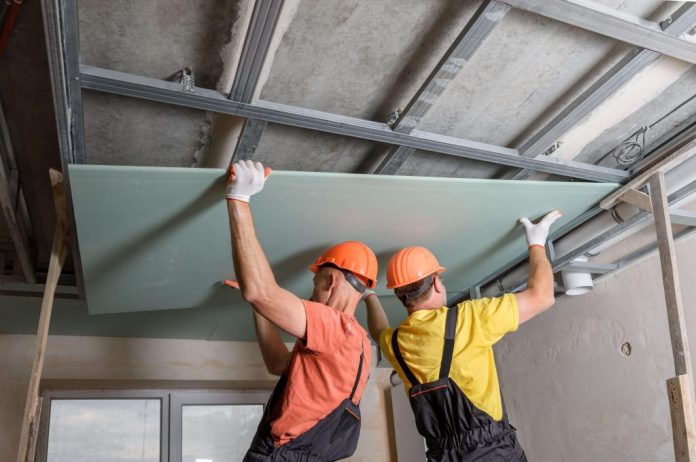Suspended ceilings offer many benefits, including aesthetic appeal, enhanced acoustics, and easy access to pipes and electrical wiring. However, like any construction feature, they can experience problems over time. Issues like sagging tiles, damaged grids, and water stains are not uncommon. In this article, we will explore some of the most common problems with suspended ceilings and provide solutions to fix them. If you need professional assistance, Suspended Ceiling Repair and Installation services are available to help ensure a seamless repair.
1. Sagging Ceiling Tiles
One of the most common issues with suspended ceilings is sagging tiles. This typically occurs due to excessive weight, moisture, or improper installation. If the tiles are too heavy or the grid system isn’t properly supported, the tiles may begin to droop or sag over time.
Solution:
To fix sagging tiles, first, inspect the grid to determine whether it’s properly aligned and supported. If the grid has weakened or bowed, it may need to be replaced or reinforced. You can also replace the sagging tiles with lightweight alternatives to reduce the load on the grid. Ensure the tiles are securely placed in the grid to prevent further sagging.
If the sagging is caused by moisture, you’ll need to address the source of the water damage first. This could be from a leaky roof or pipes. Once the moisture issue is resolved, replace the damaged tiles with new ones, and ensure the room has proper ventilation to prevent future moisture buildup.
2. Cracked or Damaged Tiles
Tiles in suspended ceilings can crack or become damaged over time due to impacts, temperature fluctuations, or age. Cracked tiles are not only unsightly but can also compromise the effectiveness of the ceiling in terms of noise reduction and insulation.
Solution:
Replacing cracked or damaged tiles is a relatively simple process. Carefully remove the damaged tile from the grid by lifting it and sliding it out of place. Measure the size of the tile and purchase a replacement that matches the original design. Insert the new tile into the grid, ensuring it fits snugly. If you can’t find an exact match, try to find a similar style or color to maintain the overall aesthetic.
3. Stains or Water Damage
Water stains are a common problem, especially in areas where plumbing or roofing issues may exist. Water from leaky pipes or a damaged roof can seep through the ceiling tiles, leaving unsightly stains and potentially compromising the structural integrity of the ceiling.
Solution:
Before replacing any damaged tiles, it’s important to address the source of the water leak. Inspect the area above the ceiling to locate the source of the leak. Once you’ve repaired the leak, remove and replace the stained or water-damaged tiles. If the water damage is extensive, the grid may also need to be replaced, especially if it has been weakened by the moisture.
In addition to replacing the damaged tiles, consider installing moisture-resistant tiles in areas that are prone to water exposure, such as bathrooms or kitchens, to prevent future issues.
4. Loose or Broken Ceiling Grids
The grid system that supports your suspended ceiling is just as important as the tiles themselves. If the grid becomes loose or broken, the ceiling may start to collapse, causing serious damage to the tiles and the ceiling structure.
Solution:
To fix a loose or broken grid, carefully inspect the grid for any broken or disconnected pieces. If you find any, remove them and replace them with new parts. For a grid that has sagged or become misaligned, use ceiling hangers to re-secure it to the original ceiling. In some cases, the grid system may need to be completely replaced if it has sustained significant damage or wear.
5. Inconsistent Ceiling Height
Sometimes, suspended ceilings can develop inconsistencies in height, where some areas are higher or lower than others. This may occur due to improper installation, shifting of the ceiling grid, or settling of the building structure.
Solution:
To fix this issue, you may need to adjust the ceiling grid. Start by checking the original installation to ensure the grid is level. If the grid is uneven, adjust the suspension wires to raise or lower the sections of the grid that are out of alignment. You may also need to replace certain suspension wires if they are stretched or damaged.
For major inconsistencies, you might need to reinstall parts of the grid system to ensure a uniform ceiling height. This may be a larger project, but it’s important to achieve a level and secure ceiling.
6. Unwanted Noises
Suspended ceilings are often chosen for their acoustic properties, but sometimes they can develop noise issues. This may be caused by vibrations in the grid, loose tiles, or external sources of sound reverberating through the ceiling.
Solution:
To reduce unwanted noise, start by checking the tiles for any gaps or spaces between them and the grid. Ensure that all tiles are securely placed in the grid, as loose tiles can rattle or vibrate. You may also want to consider adding acoustic insulation above the ceiling to improve soundproofing.
If noise continues to be an issue, you might want to invest in specialized acoustic tiles that are designed to reduce noise and improve sound absorption.
Conclusion
Suspended ceilings, while functional and stylish, can experience various problems over time. From sagging tiles to water damage, these issues are often easy to address with a bit of attention and the right tools. If you encounter persistent or complicated problems, Suspended Ceiling Repair and Installation experts can provide professional assistance to restore your ceiling to its optimal condition. By maintaining your suspended ceiling and promptly addressing any issues, you can keep your space looking great and functioning well for years to come.








